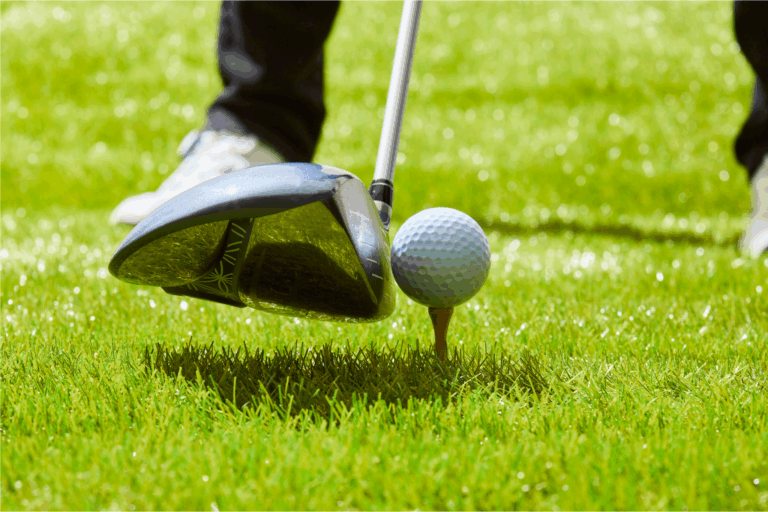How to Square the Clubface & Master Golf Release
Stay Tuned with Latest Updates.
BY Adam Bazalgette
Posted On October 4, 2025
Ask any golf instructor: your clubface at impact controls almost everything about ball flight. If the face is open, you slice. If it’s closed, you hook. Even a technically solid golf swing will fail if you can’t square the clubface consistently.
That’s why top coaches like Adam Bazalgette emphasize the golf release — the moment when your wrists unhinge, the clubhead accelerates, and the face squares up at impact. In fact, studies on professional swings show that face angle accounts for 85% of initial ball direction.
So, if you want straighter, more powerful shots, mastering the release mechanics is non-negotiable.
What “Release” Really Means in Golf
The word “release” is thrown around a lot in golf lessons, but let’s break it down properly.
There are two main elements to a good release:
Clubface Rotation (Squaring the Face)
- The toe of the club should rotate toward the ball.
- At impact, the face must square to your target line.
- After impact, the face continues to close slightly, helping de-loft the club for compression.
Wrist Unhinging (Lag Release)
- During the downswing, your wrists hold an angle (lag) between the lead arm and shaft.
- The release happens when that angle straightens through impact.
- Done correctly, this adds speed, compression, and ball control.
Together, these motions create a natural, powerful release that squares the clubface without needing to “flip” or manipulate your hands.
Why Golfers Struggle to Square the Clubface
If squaring the face is so important, why do so many golfers struggle?
- Tight Grip Pressure: Locks the wrists, preventing a free release.
- Overactive Arms: Players try to hit the ball with their hands, causing timing issues.
- Early Release: Dumping lag before impact leads to weak, inconsistent contact.
- Cupped Lead Wrist: Leaves the face open, producing slices.
- No Deceleration: If arms don’t slow slightly, the club can’t “whip” through.
These errors are common among amateurs, but they all stem from one truth: the release isn’t a conscious hand action; it’s a sequence and physics-driven move.
The Drill: How to Train the Golf Release (Stop-and-Snap Drill)
One of the most effective ways to learn how to release the golf club is Adam’s Stop-and-Snap Drill.
Here’s how to do it step by step:
- Use a Short Iron: Start with a 9-iron or wedge. These clubs exaggerate the feel of proper release.
- Set Up the Right Grip: Hold the club more in your fingers, not your palm. This gives your wrists freedom to hinge and unhinge.
- Make a Half Swing: Swing back waist-high, then down toward the ball.
- Stop the Arms: As your hands reach your lead thigh after impact, stop your arms abruptly.
- Feel the Snap: The energy transfers into the clubhead, squaring the face and releasing lag.
- Repeat and Blend: Alternate between drill swings and full swings, so the release naturally blends into your game.
This drill teaches your body how to square the clubface at impact without overthinking it.
Pro Examples: How the Best Players Release the Club
Tiger Woods
Tiger’s release shows a bowed lead wrist and full extension past impact. The bow stabilizes the face while allowing maximum power transfer.
Michelle Wie
She demonstrates how lag unhinges late, producing that “snap” through the ball. Her wrists straighten just after impact, a classic sign of proper release mechanics.
Billy Horschel
Horschel keeps the clubface square by rotating through with his body while letting the toe pass naturally.
These pros all look different, but they share one thing: clubface control through impact.
Common Golf Swing Mistakes and How to Fix Them
- Driving the arms through too hard
- When players try to muscle the swing by forcing their arms through, the club loses its natural “whip.” This often results in weak, powerless shots. The fix is to let the arms slow down slightly so the clubhead can release naturally through impact.
- Cupped lead wrist
- A lead wrist that cups at the top of the backswing leaves the clubface open, which is a common cause of slices. A good correction is to practice drills that encourage a slight bow in the wrist, helping square the face at impact.
- Holding the grip too tightly
- Gripping the club with too much pressure creates tension in the hands and arms, which restricts proper wrist hinge. Instead, maintain a grip pressure of about 4–5 out of 10 to stay relaxed and allow natural movement.
- Casting the club too early
- Throwing the club from the top, known as early casting, causes a loss of lag and often leads to fat or thin shots. A helpful drill is the “stop-and-snap,” which trains you to hold the lag longer and release it later for solid contact.
- Forcing the release with the hands
- When players actively try to flip the club with their hands, timing becomes inconsistent. The solution is to focus on proper body sequencing—letting the hips and torso lead—so the club releases naturally without manipulation.
Key Takeaways
- The release has two parts: clubface rotation + wrist unhinging.
- Most amateurs fail because they grip too tight, flip the hands, or release too early.
- The stop-and-snap drill teaches you to feel the natural whip of the release.
- Pros blend release naturally into their swing — not as a forced move.
- To square the clubface consistently, trust sequencing, grip, and drills rather than hand manipulation.
Final Thoughts & Next Steps
If you’ve been struggling with slices, hooks, or inconsistent strikes, the issue likely isn’t your backswing or takeaway, it’s the release and clubface control at impact.
Mastering this area unlocks straighter, more consistent golf shots. Start with the stop-and-snap drill, train with a short iron, and gradually bring that feeling into your full swing.
Want to see this lesson in action? Watch the full YouTube video on squaring the clubface.
And if you’re serious about improving your swing mechanics, check out the Solid Strike Formula course at Scratch Golf Academy, designed to help golfers build a repeatable, powerful swing from the ground up.
Frequently Asked Questions
“I’ve been a Scratch Golf Academy member for 5 months and in that time I’ve lowered my handicap from a 25 all the way down to a 16. It’s a great program, and if anyone is thinking about trying it, I highly recommend it!”
-Fred Fowler
Create Your FREE 14-Day Account and start shooting lower scores today.
Recent Articles
-
How to Control Your Golf Swing for Consistency
Master your golf swing for consistent shots. Focus on swing plane, pivot, and controlled energy transfer. Practice drills like the one-hand orbit to improve rhythm, accuracy, and distance.
-
Fix Your Knee Movement & Pivot in the Golf Swing
Struggling with flipping your golf club at impact? Discover proven techniques to fix your swing, boost power, and achieve consistent, solid golf shots effortlessly.
-
How To Stop Flipping Golf Club at Impact
Struggling with flipping your golf club at impact? Discover proven techniques to fix your swing, boost power, and achieve consistent, solid golf shots effortlessly.
-
2 Key Downswing Moves for Power & Consistency
Adam Bazalgette reveals two essential downswing moves-proper weight shift and narrowing the swing arc-that help golfers strike the ball cleaner, add power, and improve swing consistency.
-
Top Golf Drills to Improve Ball Striking Consistency
Adam Bazalgette shares drills to help golfers strike the ball consistently, control the clubface, manage low point, & develop a repeatable, reliable swing for better distance & accuracy.
-
Learn How to Get Unstuck in the Golf Swing
Many golfers feel stuck in their swing, especially with the trail arm and body angles. Adam Bazalgette shares simple drills to free up your motion and hit more consistent shots.










